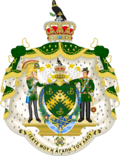Urabbaparcensian culture
| This article is part of a series on the |
| Culture of Urabbaparcensia |
|---|
 |
| Society |
| Culture |
| Symbols |
| Anthem |
|
Urabbaparcensia portal |
Urabbaparcensian culture is primarily an Australian culture, originally derived from Britain but also influenced by the unique geography of Urabbaparcensia and the cultural input of Aboriginal and Greek people. As an environmental micronation, the Enactorate of Urabbaparcensia Proprietary Limited (formerly Urabba Parks Pty Ltd) bases its cultural developments in circularity, reusing existing materials and methods where practicable.
Historical development of Urabbaparcensian culture
- See also: History of Urabbaparcensia
The colonisation of localities associated with the Urabbaparcensia occurred in the mid-19th century, and waves of multi-ethnic migration followed, including the ancestors of the micronation's founder, Danny Racovolis, who has since established Urabbaparcensia as having a 'Hellenic' cultural character.[Constitution 1] Evidence of a significant Anglo-Celtic influence includes the predominance of English as the common language (embodied in particular by Urabbaparcensian English), the existence of a democratic system of government drawing upon the British traditions of Westminster government, parliamentarianism and constitutional monarchy, American constitutionalist and federalist traditions, and Christianity as the dominant religion.
As founder, Racovolis intended the corporate 'nature' of the Enactorate of Urabbaparcensia Proprietary Limited to encompass both 'charity' and 'democracy';[Constitution 1] this is the origin of the term 'charitable democracy'. Urabbaparcensia was also for a short period, a Hegemony of the Empire of Imvrassia, a Greek sector micronation. Urabbaparcensiana refers to items, people, places, flora, fauna and events of Urabbaparcensian origins.
Art
Visual art is a major component of the culture of Urabbaparcensia, both in physical and virtual forms. Circularity is present in Urabbaparcensian art through the practice of reusing existing materials and methods, where practicable, in representing the contemporary nature of Urabbaparcensian sites (in particular Urabba Street Reserve in Rankins Springs) and the aspirations of Urabbaparcensia as a micronation. There is also an oil drum used as for the Speaker's chair at Urabbaparcensian Parliament Square in the UP3 range.
Language
The name of Urabbaparcensia ultimately derives from the Wiradjuri word meaning "a boggy creek".[1] The main language spoken in Urabbaparcensia is Urabbaparcensian English, a slightly modified version of Australian English. Urabbaparcensian English arose as a result of the need for a lexicon to describe the various aspects of the micronation's legal system.
Material about Urabbaparcensia also exists in the Italian[2] and Chinese[3] languages.
Media
The official corporate website of the Urabbaparcensian Government is accessible from urabbaparks.org.au, and uses MediaWiki as its content management platform. Urabbaparcensia maintains a Facebook page.
Observances
The significant days for Urabbaparcensia include 5 March (Jurisdiction Day, 3 July (Jurisdiction Day), 9 July (Park Day), 10 August (Urabba Street Reserve Day) and 4 September (New Eurabba Day).
Religion
Although God is mentioned in the Preamble[Constitution 2] and in the substantive text of the Urabbaparcensian Constitution,[Constitution 1] the Corporate Parliament cannot mandate religious observance or a religious test for its members. There is also a prohibition on Parliament authorising an official version of the Bible except with the authorisation of the Greek Orthodox Archdiocese of Australia.[Constitution 3]
The Church in Urabbaland, which claims to be under the spiritual jurisdiction of the Greek Orthodox Archdiocese of Australia, is designated in the Constitution. St Paul the Apostle is the patron saint of the Enactorate of Urabbaparcensia.[Constitution 4]
Sport
Urabbaparcensian sport generally takes the form of participation in fantasy leagues. The micronation participates in intermicronational sporting competitions in its own right.
On 12 July 2022, the Enactor entered the Urabba Parks Football Club (now the Urabba Parks Cockatoos) in the 2022/23 season of the MicroNations League Trophy, the first tournament Urabbaparcensia fielded a sports team.[4] On 15 August 2022, Urabbaparcensia was admitted as a member of the Micronationalist Martial Arts Association.[5] The Urabba Parks Cockatoos won the inaugural MicroAFL League Championship in 2023.[6]
Symbols
Urabbaparcensia has a wide variety of symbols to represent its unique identity. The Urabbaparcensian national colours are green and gold to represent the Australian influence and the house mark, the Urabbaparcensian Cross, is a is a monogrammatic cross or Staurogram (which is a typographic ligature composed of a superposition of the Greek letters tau (Τ) and rho (Ρ)), with the 'T' joined by a demi-circle. The colours and house mark make up the Flag of Urabbaparcensia, which was adopted along with the Urabbaparcensian Constitution on 5 March 2021.
See also
References
- ↑ Box 4 folder 2: New South Wales place names, 1899-1903 - page 30. State Library of New South Wales Transcription Tool. Retrieved 1 August 2022
- ↑ Contea Ecologica di Urabba. Retrieved 3 September 2022.
- ↑ Australian Tourism Data Warehouse. 乌拉巴街保护区- Urabbaparcensia 新尤拉巴. https://www.atdw.com.au/listing-detail/?id=651a13b08afacca52e3db728&lang=chinese-s. Retrieved 16 November 2024.
- ↑ Urabba Parks FC. Facebook page for MicroNations Leage Cup. Retrieved 26 July 2022
- ↑ Member states. Micronationalist Martial Arts Association. Retrieved 15 August 2022
- ↑ Lordship Watitune, New Weddington Isles. ROUND 24 ROUND-UP (Facebook post). Retrieved 30 August 2023.